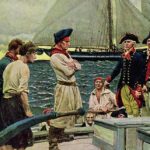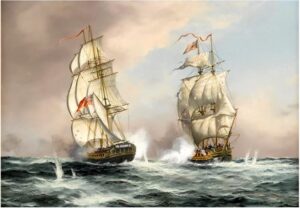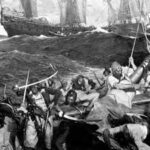
 During the Revolutionary War, the United States, being a small start-up nation did not have huge amounts of funds to build a strong navy to fight against the influx of British ships sent to try to force our nation back under the rule of Great Britain, so being the resourceful nation they were, the Continental Congress made the decision to give privateers permission to attack any and all British ships on April 3, 1776. The bill was signed by John Hancock, president of the Continental Congress at that time. The bill issued “INSTRUCTIONS to the COMMANDERS of Private Ships or vessels of War, which shall have Commissions of Letters of Marque and Reprisal, authorizing them to make Captures of British Vessels and Cargoes.”
During the Revolutionary War, the United States, being a small start-up nation did not have huge amounts of funds to build a strong navy to fight against the influx of British ships sent to try to force our nation back under the rule of Great Britain, so being the resourceful nation they were, the Continental Congress made the decision to give privateers permission to attack any and all British ships on April 3, 1776. The bill was signed by John Hancock, president of the Continental Congress at that time. The bill issued “INSTRUCTIONS to the COMMANDERS of Private Ships or vessels of War, which shall have Commissions of Letters of Marque and Reprisal, authorizing them to make Captures of British Vessels and Cargoes.”
The private commercial ships were given “Letters of Marque and Reprisal” which were the official documents by which 18th-century governments commissioned private commercial ships, known as privateers, to act on their behalf. With these documents, they were officially allowed to start attacking ships carrying the flags of enemy nations. The motivation for the “assignments” was that any goods captured by the privateer were to be divided between the ship’s owner and the government that had issued the letter. It was a pretty good deal for the privateer, because they could then sell or use the good, or sell them for a profit. It was also a good deal for the government, because the received half of the “spoils” and they didn’t have to pay the privateer. As for the British ships…well, the deal was not so good.
The orders given to the privateers by Congress were “YOU may, by Force of Arms, attack, subdue, and take all Ships and other Vessels belonging to the Inhabitants of Great Britain, on the high seas, or between high-water and low-water Marks, except Ships and Vessels bringing Persons who intend to settle and reside in the United Colonies, or bringing Arms, Ammunition or Warlike Stores to the said Colonies, for the Use of such Inhabitants thereof as are Friends to the American Cause, which you shall suffer to pass unmolested, the Commanders thereof permitting a peaceable Search, and giving satisfactory Information of the Contents of the Ladings, and Destinations of the Voyages.”
The reality was that whether they were called privateers or pirates, the real distinction between the two was non-existent, at least to those who faced them on the high seas. The men were given the right to behave just 
 like pirates, so they behaved just like pirates, boarding and capturing ships and using force if necessary. The good news for the privateers was that privateers holding Letters of Marque were not subject to prosecution by their home nation and, if captured, were treated as prisoners of war instead of criminals by foreign nations. Even if they were caught, this was the best-case scenario for the privateers, and they were the best thing for this country at that important time in our history.
like pirates, so they behaved just like pirates, boarding and capturing ships and using force if necessary. The good news for the privateers was that privateers holding Letters of Marque were not subject to prosecution by their home nation and, if captured, were treated as prisoners of war instead of criminals by foreign nations. Even if they were caught, this was the best-case scenario for the privateers, and they were the best thing for this country at that important time in our history.


Leave a Reply